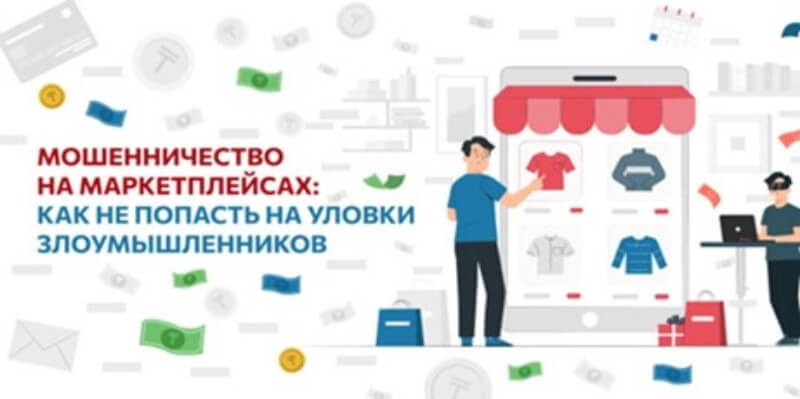Shopping on marketplaces has become a familiar and comfortable way for many to make bulk purchases. It allows you to buy a liked model of clothing or other goods at any convenient time with minimal effort. However, without proper vigilance, there is a risk of falling victim to scammers. How to spot fake sellers and shop safely?
Financial experts are recording a surge in fraud on popular platforms. Scammers on online sales platforms persuade customers to move the order processing dialogue to another platform and then proceed to actions there - urging a 100% prepayment. The growth of such scams is only increasing day by day.
When making a purchase online, you cannot see the product in person. You also cannot check the quality. You can only rely on the product description and posted reviews. But how to ensure the safety of online shopping?
Signs of a Fake Seller
When visiting an online store, it is important not only to pay attention to the goods but also to notice some cues pointing to fake seller accounts. Identifying them is not easy, but possible. To ensure safe shopping and prevent negative consequences, you should know the main signs of a fake seller:
- The price may be significantly lower compared to other platforms;
- Unavailable courier delivery and pick-up service;
- No information about the store, no ways to contact the seller;

- The marketplace was created recently. The date of its founding can be found in the site footer or by checking the domain address in publicly available registries;
- No description or differs from the competitor store's product characteristics;
- Sellers insistently urge to hurry with order processing, conduct the dialogue by phone;
- Mandatory prepayment, recommended to make directly to a private individual's card or through a dubious electronic payment system, the name of which is little known;
- The seller shows scanned copies of documents proving identity to gain trust. In the era of innovative programs, creating forged documents digitally for scammers on online sales platforms is not a problem.

There is another common scam principle. Often, scammers create clone sites of modern brand stores or popular online cinemas. Domain addresses usually differ by only a couple of symbols that an inactive user may not notice. By visiting the site and paying for services, the person voluntarily makes a payment to the scammer's account.
How to Spot Fake Sellers
Several deceptive schemes are widespread, used by criminals.
1. Incredible discounts - during the pre-holiday period or during large-scale promotions, all users receive promotional emails with huge discounts. The messages from the marketplace contain a link leading to a phishing clone site of an existing online store, where after filling out the registration form and providing bank details, access to the funds on the card is opened. 2. Support scam - it is not uncommon for an unpleasant situation to arise after purchasing a product from a website. The outraged customer shares the situation on forums. Scammers intercept the comment, pretend to be the support service of the store where the purchase was made and the conflict arose. They offer the customer compensation for the inconvenience caused. To receive a monetary bonus as an apology from the store, you need to follow a link and enter card details. At this point, instead of a refund, the money is deducted.

3. Situations where a representative's e-commerce account is stolen are very common. This is done to be able to purchase goods through the card linked to the account. 4. Job offers - sometimes stores offer different work options. In this situation, it is important to check whether vacancies are really announced from an official email or a real account on social networks. If there are no specifics and detailed information about vacant positions is absent, it is possible that the offers are from scammers. 5. Review scam - often before ordering a product, a potential customer reads reviews. There are cases when under a negative product review, someone writes that they found an identical model but of better quality and at a lower price - and then a website is posted. By clicking the link and ordering the product, the customer is unlikely to receive the ordered item.
To shop safely, it is important to know about the existing traps of fake online stores and be able to recognize fake seller accounts.
How to Avoid Fraud on Sales Platforms
To avoid falling for fake marketplaces and losing funds, you should follow these recommendations:
- do not trust suspiciously huge discounts;
- check websites and official supermarket apps;
- read reviews written by real buyers, not bots;
- set a minimum limit for online purchases and regularly update the marketplace password;
- you can connect a separate card for online purchases and have a small amount on the balance;
- do not believe announced vacancies offered by stores through social networks.
For bulk purchases, it is better to choose proven platforms that have been around for more than a year and have already been tested by many users. Thus, the risk of encountering scammers is minimized.
Online Shopping Safety
Is shopping online dangerous? In most cases, online shopping is safe. However, due to a lack of time, buyers often do not check information about marketplaces and make rash actions.

It is important to choose well-known online stores with a good reputation. Even in these cases, vigilance must be maintained. As scammers may disguise themselves as a popular retail outlet. If you are dealing with specialized products, medicines, equipment, medical products, it is always worth checking the sales platform contacts before providing personal financial data.
Another positive sign is having a connection with the seller to adjust and resolve a disputable situation should unforeseen problems with the order arise. Video reviews can also be good assistants in determining a genuine store.
